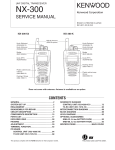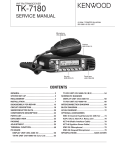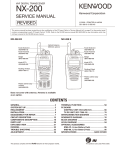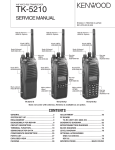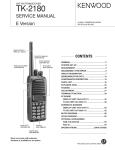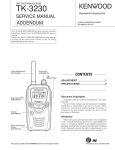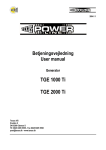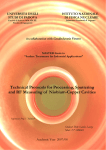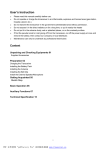Download TK-7180/7189 TK-8180/8189
Transcript
VHF FM TRANSCEIVER TK-7180/7189 TK-8180/8189 UHF FM TRANSCEIVER SERVICE MANUAL ADDENDUM © 2005-3 PRINTED IN JAPAN B51-8732-00 (N) PDF MPT Trunking Version Use this service manual together with the following service manuals. • TK-7180 service manuals (B51-8691-00, B51-871200 and B51-8713-00) • TK-7189 service manual (B51-8713-00) • TK-8180 service manuals (B51-8692-00, B51-870200, B51-8712-00 and B51-8714-00) • TK-8189 service manual (B51-8714-00) CONTENTS SYSTEM SET-UP ...................................................................................... 2 REALIGNMENT ......................................................................................... 3 INSTALLATION ......................................................................................... 5 ADJUSTMENT ........................................................................................ 12 TK-7180/7189 ...................................................................................... 17 TK-8180/8189 ...................................................................................... 22 This product uses Lead Free solder. TK-7180/7189/8180/8189 SYSTEM SET-UP Merchandise received Choose the type of transceiver Are you using the remote kit? YES Frequency range RF power Type 450~520MHz 30W (490~520MHz : 25W) TK-8180 K 400~470MHz 30W TK-8180 K2 400~470MHz 25W TK-8180 E 400~470MHz 25W TK-8189 E 136~174MHz 30W TK-7180 K 136~174MHz 25W TK-7180 E 136~174MHz 25W TK-7189 E See page 7. KRK-10 (Option) NO Are you using the ignition sense cable? YES See page 5. KCT-46 (Option) NO Transceiver programming Are you using the public address? See page 3. A personal computer (IBM PC or compatible), programming interface (KPG-46), and programming software (KPG-96D) are required for programming. YES See page 6. KAP-2 (Option) NO Are you using the voice guide & storage unit? NO YES Are you using the external speaker? YES (Option) See page 9. When the KAP-2 is installed (Option) in the transceiver, the KES-5 can be installed. KES-3 or KES-5 External speaker NO Are you using the keypad microphone? NO Delivery 2 See page 8. VGS-1 YES KMC-32 or KMC-36 (Option) Desk top microphone KMC-9C TK-7180/7189/8180/8189 REALIGNMENT 1. Modes 2. How to Enter Each Mode Mode User mode Panel test mode Panel tuning mode Data programming mode PC mode Firmware programming mode PC test mode PC tuning mode Transceiver information mode Operation User mode Power ON Panel test mode [A] + Power ON PC mode Received commands from PC Panel tuning mode [Panel test mode] + [S] Firmware programming mode [S] + Power ON Transceiver information mode [B] + Power ON Firmware version information [ Clock adjustment mode [C] + Power ON ] + Power ON Firmware version information 3. Panel Test Mode Setting method refer to ADJUSTMENT. Clock adjustment mode Mode Function User mode For normal use. Panel test mode Used by the dealer to check the funda- 4. Panel Tuning Mode Setting method refer to ADJUSTMENT. mental characteristics. Panel tuning mode Used by the dealer to tune the transceiver. 5. PC Mode PC mode Used for communication between the 5-1. Preface transceiver and PC (IBM compatible). Data programming mode Used to read and write frequency data and other features to and from the transceiver. PC test mode Used to check the transceiver using the PC. The transceiver is programmed by using a personal computer, programming interface (KPG-46) and programming software (KPG-96D). The programming software can be used with an IBM PC or compatible. Figure 1 shows the setup of an IBM PC for programming. This feature is included in the FPU. IBM PC See panel test. PC tuning mode KPG-46 or KPG-46 + Tuning cable (E30-3383-05) Used to tune the transceiver using the PC. This feature is included in the FPU. See panel tuning. Firmware Used when changing the main program programming mode of the flash memory. Transceiver Used to confirm the MPT ESN, firmware information mode version and transceiver serial number. Firmware version Used to confirm the internal firmware information version. Clock adjustment Used by the dealer to adjust date and mode time. KPG-96D Fig. 1 3 TK-7180/7189/8180/8189 REALIGNMENT 5-2. Connection procedure 1. Connect the transceiver to the personal computer with the interface cable. 2. When the POWER switch on, user mode can be entered immediately. When PC sends command the transceiver enter PC mode, and “PROGRAM” is displayed on the LCD. When data transmitting from transceiver, the red LED is lights. When data receiving to transceiver, the green LED is lights. Note: The data stored in the personal computer must match model type, when it is written into the flash memory. 5-3. KPG-46 description (PC programming interface cable: Option) The KPG-46 is required to interface the transceiver to the computer. It has a circuit in its D-subconnector (25-pin) case that converts the RS-232C logic level to the TTL level. The KPG-46 connects the modular microphone jack of the transceiver to the computers RS-232C serial port. 5-4. Programming software KPG-96D description The KPG-96D is the programming software for the transceiver. This software runs under MS-Windows 98, ME, Windows 2000 or XP on an IBM-PC or compatible machine. The data can be input to or read from the transceiver and edited on the screen. The programmed or edited data can be printed out. It is also possible to tune the transceiver. 6. Firmware Programming Mode 6-1. Preface Flash memory is mounted on the transceiver. This allows the transceiver to be upgraded when new features are released in the future. (For details on how to obtain the firmware, contact Customer Service.) 6-2. Connection procedure Connect the transceiver to the personal computer (IBM PC or compatible) with the interface cable (KPG-46). (Connection is the same as in the PC Mode.) Note: You can only program firmware from the 8-pin microphone connector on the front panel. Using the 25-pin logic interface on the rear panel will not work. 3. Set the firmware to be updated by File name item. 4. Turn the transceiver power ON with the [S] key held down. Then, the orange LED on the transceiver lights and “PROG 115200” is displayed. 5. Check the connection between the transceiver and the personal computer, and make sure that the transceiver is in the Program mode. 6. Press write button in the window. When the transceiver starts to receive data, the [PG] display is blinking. 7. If writing ends successfully, the checksum is calculated and a result is displayed. 8. If you want to continue programming other transceivers, repeat steps 4 to 7. Note: This mode cannot be entered if the Firmware Programming mode is set to Disable in the Programming software. 6-4. Function 1. If you press the [ ■ ] key while “PROG 115200” is displayed, the display changes to “PROG 19200” (The LED blinks green) to indicate that the write speed is low speed (19200 bps). If you press the [■ ] key again while “PROG 19200” is displayed, the display changes to “PROG 38400” (The LED lights red and orange alternatively). If you press the [ ■ ] key again while “PROG 38400” is displayed, the display changes to “PROG 57600” (The LED blinks orange). If you press the [ ■ ] key again while “PROG 57600” is displayed, the display returns to “PROG 115200” (The LED lights orange). 2. If you press the [ ] key while “PROG 115200” is displayed, the checksum is calculated, and a result is displayed. If you press the [ ] key again while the checksum is displayed, “PROG 115200” is redisplayed. Note: Normally, write in the high-speed mode. 7. Transceiver Version Information Mode Use this function to comfirm the MPT ESN, firmware version and transceiver serial number. 1. Press and hold the [B] key for 2 seconds while turning the transceiver power ON. 2. Use the [ ] and [ ] keys to select the confirmation items. 3. To exit the transceiver information mode, turn the transceiver power OFF. MPT ESN 6-3. Programming 1. Start up the firmware programming software (Fpro.exe). 2. Set the communications speed (normally, 115200 bps) and communications port in the configuration item. 4 [ ]/[ ] Serial number [ ]/[ ] [ ] / [ ] Firmware version TK-7180/7189/8180/8189 REALIGNMENT / INSTALLATION 8. Firmware Version Information Turn the transceiver ON with the [ ] key held down. Then, the version is displayed during holding the [ ] key. 9. Clock Adjustment Mode INSTALLATION 1. Ignition Sense Cable (KCT-46 : Option) The KCT-46 is an optional cable for enabling the ignition function. The ignition function lets you turn the power to the transceiver on and off with the car ignition key. 9-1. Flow chart of operation 1-1. Connecting the KCT-46 cable to the transceiver [C] + Power ON YEAR [ ] and [ ] keys [S] MONTH [ ] and [ ] keys [S] DAY [ ] and [ ] keys [S] HOUR [ ] and [ ] keys Note: You must setup using the KPG-96D. [S] MINUTE 1. Open the KCT-46 fuse holder and insert a mini blade fuse (3A). ( q ) 2. While holding a clear protective cover, remove the black cap at the end of the yellow cable (ignition sense cable) of the transceiver. ( w ) 3. Connect the plug of the KCT-46 to the yellow cable terminal of the transceiver. ( e ) 4. Connect the other end of the KCT-46 to the ignition line of the car. ( r ) [ ] and [ ] keys [S] Completion w e F52-0019-05 q r Iginition line of the car Fig. 1 5 TK-7180/7189/8180/8189 INSTALLATION 2. Horn Alert/P.A. Relay Unit (KAP-2 : Option) The Horn alert (max. 2A drive), Public address and External speaker function are enabled by installing the KAP-2 in the transceiver. 2-1. Installing the KAP-2 unit in the transceiver (The kit A is not used in the KAP-2 accessories) 1. Remove the cabinet, top packing and shielding plate of the transceiver. 2. Set the KAP-2 relay unit jumper pins according to the purpose of use. 3. Remove the 6-pin jumper connector inserted in the TX-RX unit (B/3) connector (CN428). ( q ) 4. Insert one side of the lead wire with connector (E37-111405) into the relay unit connector (CN3) ( w ) and the other side into the TX-RX unit (B/3) connector (CN428) ( e ). 5. Place the relay unit at the position shown in Figure 2-2 and secure it to the chassis with a screw. 6. Remove the cap on the rear of the chassis by pushing it from the inside with your finger. ( r ) 7. Pass the 6-pin connector of the cable (E37-1113-05) through the chassis hole ( t ) and insert the bush into the chassis hole. 8. Rotate the bush of the cable 90 degrees counterclockwise as viewed from the rear of the chassis. ( y ) 9. Insert the 6-pin connector of the cable into the connector (CN2) of the KAP-2 relay unit. ( u ) Note : You must setup using the KPG-96D. E37-1114-05 w CN3 e q CN428 CN428 Fig. 2-1 r Fig. 2-2 Fig. 2-3 y t CN2 E37-1113-05 Fig. 2-4 6 u TK-7180/7189/8180/8189 INSTALLATION 3. Control Head Remote Kit (KRK-10 : Option) The KRK-10 remote kit is used to remotely operate the transceiver. 3-1. Installing the KRK-10 kit to the transceiver 1. 2. 3. 4. Remove the front panel from the transceiver. Install the KRK-10 main panel onto the transceiver. Install the KRK-10 rear panel onto the front panel. Connect the KRK-10 main panel to the rear panel with the cable. ■ Install the KRK-10 main panel onto the transceiver 4. Insert the flat cable that was removed in step 2 above into the connector (CN1) of the interface unit (A/2) of the KRK10 main panel (A62-1101-01). ( u ) Note : The terminal side of the flat cable must face down when inserting the flat cable into the connector. 5. Fit the main panel with four tabs onto the front of the chassis. ( i ) Note : When installing the main panel onto the front of the chassis, hold down the flat cable with your fingers to prevent it from being caught. ■ Remove the front panel from the transceiver KRK-10 main panel 1. Lift the two tabs of the panel on the bottom of the transceiver with a flat-head screwdriver ( q ) and remove the panel from the chassis ( w ). Note : Confirm that the tabs of the speaker hardware fixture and holder is securely fitted in the front panel. 2. Remove the flat cable from the connector (CN902) of the display unit of the panel. ( e ) 3. Fold the black line of the flat cable (in three parts) as shown in Figure 3-2. ( r, t, y ) CN1 i u CN902 Fig. 3-3 e ■ Install the KRK-10 rear panel onto the front panel w q 6. Insert the flat cable attached to the interface unit (B/2) of the KRK-10 rear panel (A82-0056-11) into the connector (CN902) of the display unit of the panel ( o ). (The flat cable has been pre-inserted in the connector (CN2) of the rear panel at the time of shipping.) Note : The terminal side of the flat cable must face down when inserting the flat cable into the connector. 7. Fit the four tabs of the rear panel into the front panel. ( !0 ) CN902 o Fig. 3-1 Chassis side y CN2 KRK-10 rear panel r t y r !0 t Panel side Fig. 3-4 Fig. 3-2 7 TK-7180/7189/8180/8189 INSTALLATION ■ Connect the KRK-10 main panel to the rear panel with the cable 8. Insert one 14-pin connector of the cable (E30-7514-05) into the connector (CN3) of the interface unit (A/2) of the main panel. ( !1 ) 9. Secure the cable bush on the main panel and fit the waterproof packing (orange) ( !2 ) securely over top. CN4 !8 !5 !8 !7 10. Install the molded cover ( !3 ) over the connector on the main panel and secure it with two screws ( !4 ). 11. Insert the other 14-pin connector of the cable into the connector (CN4) of the interface unit (B/2) of the rear panel. ( !5 ) 12. Secure the cable bush on the rear panel and fit the waterproof packing (orange) ( !6 ) securely over top. 13. Install the molded cover ( !7 ) over the connector on the rear panel and secure it with two screws ( !8 ). Note : A cable can be connected from the left side as shown in the Figure 3-5 or from right side. However, the 14-pin connector must be connected to correct direction. !6 CN3 !1 !2 !4 !3 !4 !2 (Right side) Fig. 3-5 4. Voice Guide & Storage Unit (VGS-1 : Option) 4-1. Installing the VGS-1 unit in the transceiver 1. Remove the cabinet, top packing and shielding plate of the transceiver. 2. Attach two cushions to VGS-1 as shown in Figure 4. ( q ) Note : Be sure not to cover the connector with the bottom cushion. 3. Insert the VGS-1 connector (CN1) into the TX-RX unit (B/3) connector (CN403). ( w ) Note : You must setup using the KPG-96D. q Cushion (G13-1994-04) 20 x 30 x 12 mm VGS-1 CN1 Cushion (G13-1992-04) 21 x 21 x 2.5 mm 8 w CN403 Fig. 4 TK-7180/7189/8180/8189 INSTALLATION 5. External Speaker (Option) 5-1. KES-3 The KES-3 is an external speaker for the 3.5-mm-diameter speaker jack. ■ Connection Procedure Insert the crimp terminal into the Square plug supplied with the KAP-2. ■ Connection Procedure 1. Connect the KES-3 to the 3.5-mm-diameter speaker jack on the rear of the transceiver. Black/White lead 4 Square plug (E59-0419-05) 5 Black lead Insulating cover (F29-0481-05) Fig. 5-3 Fig. 5-1 ■ KAP-2 Cable (E37-1113-05) 6-pin Connector 5-2. KES-5 External speaker KES-5 can be installed for KAP-2. If KES5 is installed, it can be set by changing the CN1 short pin from pins 4 and 5 to pins 5 and 6 on the KAP-2. KAP-2 CN1 Connect Set Up 4-5 INT. SP or KES-3 5-6 KES-5 When you use the KES-5, plug the short pin to pins 5 and 6 on the KAP-2. When you use the INT. SP or KES-3, plug the short pin to pins 4 and 5 on the KAP-2. 1 2 3 4 5 6 Pin No. Color Name 1 Red HR2 2 Blue GND 3 Yellow OSP 4 Green ESP 5 Brown GND 6 Black HR1 1 INT CN1 INT. SP or KES-3 EXT HR2 HR1 KAP-2 unit 6 KES-5 Short pin Fig. 5-2 9 TK-7180/7189/8180/8189 INSTALLATION 6. Voice Scrambler Board Connection 7. GPS Receiver Connection 1. Remove the front panel from the transceiver. 2. Solder each lead of the scrambler board to a necessary location of each landing on the component side of the TXRX unit (B/3). 3. Wrap the scrambler board in a cushion and install it on the front of the chassis as shown in Figure 6-1. 7-1. Installing the GPS receiver Fig. 6-1 Note : You must setup using the KPG-96D. TX-RX unit (B/3) Solder land GND (GND) RXD1 (DATA OUT1)*1 TXD1 TXD2 RXD2 (DATA OUT1)*1 OPT1 OPT3 OPT4 OPT5 5E (+5V) DTI TCTL TXO AUDIH OPT2 STON RXEO TXI RXEI OPT6 8C GPS receiver TX-RX unit (B/3) Solder land GND (GND) RXD1 TXD1 (PTT) TXD2 RXD2 OPT1 (CODE SELECT1) OPT3 (CODE SELECT2) OPT4 (ECHO PTT) OPT5 (CODE SELECT8) 5E DTI TCTL TXO (TX OUT) AUDIH OPT2 (SCRAMBLE) STON RXEO (RX OUT) TXI (TX IN) RXEI (RX IN) OPT6 (CODE SELECT4) 8C (+V) Voice scrambler board Note : You must setup using the KPG-96D. 1. Remove the cabinet, top packing and shielding plate of the transceiver. 2. Remove the front panel from the transceiver. 3. Attach two cushions to the top of the GPS receiver. 4. Attach the GPS receiver to the shield case with two cushions as shown in Figure 7-2. 5. Solder each lead of the GPS receiver to a necessary location of each landing on the component side of the TX-RX unit (B/3). 6. Place the GPS antenna cable in the hollow at the rear of the chassis. (Fig. 7-2 q ) Note : If the GPS receiver is installed, cut the base of the convex tab of the top packing with a pair of nippers, or similar tool. (Fig. 7-3 w ) If the convex tab of the top packing is cut off, the water proofing property is no longer guaranteed. *1 : Depending on the connected optional accessory, the DATA OUT1 may connect to either RXD1 or RXD2. 3M double coated cushion No. 4008 (or No.4408) 25 x 110 mm Voice scrambler board Fig. 6-2 10 Fig. 7-1 TK-7180/7189/8180/8189 INSTALLATION 4. Insert the VGS-1 connector (CN1) into the TX-RX unit (B/3) connector (CN403). 5. Perform step 3 to 6 of “7-1. Installing the GPS receiver” described on page 10. 3M Double coated cushion No. 4016 (or No. 4416) 30 x 25 mm 3M Double coated cushion No. 4016 (or No. 4416) 30 x 25 mm q TX-RX unit (B/3) Solder land GND (GND) RXD1 TXD1 TXD2 RXD2 (DATA OUT1) OPT1 OPT3 OPT4 OPT5 5E (+5V) DTI TCTL TXO AUDIH OPT2 STON RXEO TXI RXEI OPT6 8C GPS receiver Note : You must setup using the KPG-96D. GPS receiver Fig. 7-4 Fig. 7-2 GPS receiver VGS-1 CN1 w Fig. 7-3 CN403 7-2. Installing the GPS receiver together with the VGS-1 1. Remove the cabinet, top packing and shielding plate of the transceiver. 2. Remove the front panel from the transceiver. 3. Attach a cushion to the bottom of the VGS-1 as shown in Figure 7-5. Note : Be sure not to cover the connector with the cushion. Fig. 7-5 11 TK-7180/7189/8180/8189 ADJUSTMENT Controls “FNC” appears Key Power Volume switch Up/Down key Modular MIC jack LCD Function Channel Up/Down key Programmable function keys [S] High power / Low power Low : [A] Function off - [B] Compander on/off On : icon appears [C] Beat shift on/off On : icon appears [ ]/[ ] Function off - [ ]/[ ] Function off - [ Squelch level 0 On : [■ ] LCD all lights LCD all point appears [0] to [9] Function off - ] Panel Test Mode and [#], ■ Test mode operation features [✳] *2 This transceiver has a test mode. To enter test mode, press [A] key and turn power on. Hold [A] key until frequency version appears on LCD. Test mode can be inhibited by programming. To exit test mode, switch the power on again. The following functions are available in test mode. Display icon appears icon appears Microphone key [PTT] Transmit - [0] to [9] Function off - and [A], ■ Key operation [B], [C], “FNC” not appears [D], [#], Key Function Display [S] Shifts to Panel tuning mode - [A] Function on “FNC” appears [B] MSK 1200bps and 2400bps 2400bps : [C] Test signaling CH up Signaling No. [ ]/[ ] Test frequency CH up/down Channel No. • LED indicator [ ]/[ ] Volume up/down - Red LED Green LED [ Squelch on/off Narrow : “n” • Sub LCD indicator ] [■ ] Narrow/Wide Wide : “w” [0] to [9] Use as the DTMF keypad. and [#], If a key is pressed during [✳] *1 transmission, the DTMF - icon appears Note: If a [S], [A], [B], [C] key is pressed during transmission, the DTMF corresponding to the key that was pressed is sent. “FNC” Lights during transmission. Lights when there is carrier. Appears at function on. • LCD display in panel test mode n : Narrow w : Wide that was presses is sent. Microphone key [PTT] Transmit - [0] to [9] Use as the DTMF keypad. - and [A], If a key is pressed during [B], [C], transmission, the DTMF [D], [#], corresponding to the key [✳] that was presses is sent. *1 : TK-7189 and TK-8189 models only *2 : TK-7189 and TK-8189 models only n corresponding to the key 12 [✳] 1 – 1 Signaling No. Channel No. TK-7180/7189/8180/8189 ADJUSTMENT ■ Frequency and Signaling • Test signaling The transceiver has been adjusted for the frequencies shown in the following table. When required, readjust them following the adjustment procedure to obtain the frequencies you want in actual operation. • Test frequency 136~174MHz (TK-7180 K,E/7189 E) No. RX TX 1 None None 2 None 100Hz Square Wave 3 Skip 4 QT : 67.0Hz QT : 67.0Hz 5 QT : 151.4Hz QT : 151.4Hz 6 QT : 210.7Hz QT : 210.7Hz 7 QT : 254.1Hz QT : 254.1Hz 8 DQT : D023N DQT : D023N DQT : D754I CH RX (MHz) TX (MHz) 1 155.05000 155.10000 2 136.05000 136.10000 3 173.95000 173.90000 9 DQT : D754I 4 155.00000 155.00000 10 Skip 5 155.20000 155.20000 11 None 6 155.40000 155.40000 12 Skip 7 177.95000 177.90000 13 Skip - 14 None 15 Skip 16 None MSK 17 8~16 - 450~520MHz (TK-8180 K) DTMF Code 9 Single Tone : 1000Hz CH RX (MHz) TX (MHz) MSK : MSK : 1 485.05000 485.10000 Preamble : 0xAAAA Preamble : 0xAAAA 2 450.05000 450.10000 Sync : 0x23EB Sync : 0x23EB 3 519.95000 519.90000 Data : 0x230960C6AAAA Data : 0x230960C6AAAA 4 485.00000 485.00000 CRC : 0xC4D7 CRC : 0xC4D7 5 485.20000 485.20000 6 485.40000 485.40000 7~16 - - 400~470MHz (TK-8180 K2,E/TK-8189 E) CH RX (MHz) TX (MHz) 1 435.05000 435.10000 2 400.05000 400.10000 3 469.95000 469.90000 4 435.00000 435.00000 5 435.20000 435.20000 6 435.40000 435.40000 7~16 - - Panel Tuning Mode ■ Preparations for tuning the transceiver Before attempting to tune the transceiver, connect the unit to a suitable power supply. Whenever the transmitter is turned, the unit must be connected to a suitable dummy load (i.e. power meter). The speaker output connector must be terminated with a 4Ω dummy load and connected to an AC voltmeter and an audio distortion meter or a SINAD measurement meter at all times during tuning. ■ Transceiver tuning (To place transceiver in tuning mode) Press [S] key, now in tuning mode. Use [B] key to write tuning data through tuning modes, and [ ]/[ ] to adjust tuning requirements (1 to 256 appears on LCD). Use [C] key to select the adjustment item through tuning modes. Use [A] key to adjust 3 or 5 reference level adjustments, and use [■ ] key to switch between Wide/Narrow. Channel appears on LCD. Set channel according to tuning requirements. • LCD display in panel tuning mode n n : Narrow w : Wide BAL 256 Adjustment value (1~256) Adjustment item 13 TK-7180/7189/8180/8189 ADJUSTMENT ■ Adjustment item and Display (✳✳✳ : 1~256, Only MSK : 1~64) ■ Key operation Function Key Push Hold (1 second) Adjustment item Display ✳✳✳ [S] End of panel tuning mode - 1 Frequency FREQ [A] To enter 3 or 5 reference - 2 Shift 1 SHFT1 ✳✳✳ 3 Shift 2 SHFT2 ✳✳✳ level adjustments [B] Writes the adjustment value - 4 Max high power M HPWR ✳ ✳ ✳ [C] Go to next adjustment item Back to last adjustment item 5 Max low power M LPWR ✳ ✳ ✳ [ ]/[ ] Adjustment value up/down Continuation up/down 6 High power HPWR ✳✳✳ [ ]/[ ] Volume level up/down Continuation up/down 7 Low power LPWR ✳✳✳ [ Squelch on/off - 8 Balance BAL ✳✳✳ Selects Narrow, Wide - 9 Max deviation DEV ✳✳✳ 10 QT QT ✳✳✳ 11 DQT DQT ✳✳✳ 12 DTMF DTMF ✳✳✳ 13 MSK MSK 14 Tone TONE 15 Sensitivity 1 SENS1 ✳✳✳ 16 Squelch SQL ✳✳✳ 17 Low RSSI LRSSI ✳✳✳ 18 Squelch tight SQLT ✳✳✳ 19 High RSSI HRSSI ✳✳✳ ] [■ ] ■ 3 or 5 reference level adjustments frequency 136~174MHz (TK-7180 K,E/7189 E) Tuning point RX (MHz) TX (MHz) Low 136.05000 136.10000 Low’ 145.55000 145.60000 Center 155.05000 155.10000 High’ 164.55000 164.60000 High 173.95000 173.90000 450~520MHz (TK-8180 K) Tuning point RX (MHz) TX (MHz) Low 450.05000 450.10000 Low’ 467.55000 467.60000 Center 485.05000 485.10000 High’ 502.55000 502.60000 High 519.95000 519.90000 400~470MHz (TK-8180 K2,E/TK-8189 E) Tuning point 14 Order RX (MHz) TX (MHz) Low 400.05000 400.10000 Low’ 417.55000 417.60000 Center 435.05000 435.10000 High’ 452.55000 452.60000 High 469.95000 469.90000 ✳✳ ✳✳✳ TK-7180/7189/8180/8189 ADJUSTMENT ■ Flow chart Frequency [C] Shift 1 [C] Shift 2 [C] Max high power [C] Max low power [C] High power [C] Low power [C] Balance [C] Narrow [A] Max deviation Narrow [C] [A] QT [C] Narrow [A] DQT [C] Narrow [A] DTMF [C] Narrow MSK [C] Tone [C] Narrow Narrow 3 reference level adjustments [A] 3 reference level adjustments [A] 5 reference level adjustments [A] 5 reference level adjustments [A] 5 reference level adjustments [A] 5 reference level adjustments [ [ [ [ ] ] ] ] [ ] [ ] [ ] Balance [C] Wide Max deviation [C] Wide QT [C] Squelch [C] Narrow [A] Low RSSI [C] Narrow [A] Squelch tight Narrow [C] [A] Narrow [A] [ [ [ [ Low [C] Center [C] High [C] [A] [A] [A] 3 reference level adjustments exit ] [ ] 3 reference level adjustments Wide [ ] 5 reference level adjustments 3 reference level adjustments Wide DTMF [C] Wide Tone [C] 3 reference level adjustments 3 reference level adjustments DQT [C] MSK [C] [ [ 3 reference level adjustments Wide Wide [ ] [ ] [ ] Low [C] Low’ [C] ] [A] Sensitivity 1 [C] High RSSI [C] [A] Center [C] High’ [C] High [C] [A] [A] [A] [A] [A] 5 reference level adjustments exit 5 reference level adjustments ] ] ] ] Squelch [C] Wide [A] Low RSSI [C] Wide [A] Squelch tight [C] Wide [A] High RSSI [C] Wide [A] [ ] 3 reference level adjustments [ ] 3 reference level adjustments [ ] 3 reference level adjustments [ ] 3 reference level adjustments 15 TK-7180/7189/8180/8189 ADJUSTMENT Test Equipment Required for Alignment Test Equipment 1. Standard Signal Generator (SSG) 2. Power Meter Major Specifications Frequency Range 136 to 174MHz (TK-7180/7189), 400 to 520MHz (TK-8180/8189) Modulation Frequency modulation and external modulation Output 0.1µV to greater than 1mV Input Impedance 50Ω Operation Frequency 136 to 174MHz or more (TK-7180/7189), 400 to 520MHz or more (TK-8180/8189) Measurement Capability Vicinity of 50W 3. Deviation Meter Frequency Range 136 to 174MHz (TK-7180/7189), 400 to 520MHz (TK-8180/8189) 4. Digital Volt Meter Measuring Range 1 to 20V DC Accuracy High input impedance for minimum circuit loading (DVM) 5. Oscilloscope DC through 30MHz 6. High Sensitivity Frequency Counter Frequency Range 10Hz to 600MHz Frequency Stability 0.2ppm or less 7. Ammeter 13A or more 8. AF Volt Meter Frequency Range (AF VTVM) 9. Audio Generator (AG) 10. Distortion Meter 11. Voltmeter 50Hz to 10kHz Voltage Range 3mV to 3V Frequency Range 50Hz to 5kHz Output 0 to 1V Capability 3% or less at 1kHz Input Level 50mV to 10Vrms Measuring Range 10 to 1.5V DC or less Input Impedance 50kΩ/V or greater 12. 4Ω Dummy Load Approx. 4Ω, 20W 13. Regulated Power Supply 13.6V (K,K2), 13.2V (E), approx. 20A (adjustable from 9 to 20V) Useful if ammeter requipped Test cable for microphone input (E30-3360-08) 1 2 3 4 5 6 7 8 GREEN 1 RED 2 BLACK E BLUE SHIELD PTT MIC-E WHITE MIC GRAY HK YELLOW 3 4 Tuning cable (E30-3383-05) Adapter cable (E30-3383-05) is required for injecting an audio if PC tuning is used. See “PC Mode” section fot the connection. 5 6 7 8 Lead wire + Shield wire – MIC MIC connector (Front panel view) Check Jig for the VGS-1 KENWOOD part : W05-1127-00 8 1 1 : BLC 2 : +B 3 : GND 4 : PTT/TXD (PC serial data from radio) 5 : MICE 6 : MIC 7 : HOOK/RXD (PC serial data to radio) 8 : DM to transceiver to VGS-1 16 TK-7180/7189/8180/8189 ADJUSTMENT TK-7180/7189 Common Section Measurement Item Condition Testequipment Unit Terminal 1. Setting 1) Power supply voltage DC power supply terminal : 13.6V K, 13.2V E 2) SSG standard modulation [Wide] MOD : 1kHz, DEV : 3kHz [Narrow] MOD : 1kHz, DEV : 1.5kHz 2. VCO lock voltage • RX [Panel test mode] 1) CH-Sig : 3-1 Power meter Rear panel ANT 2) CH-Sig : 2-1 DVM CV • TX TX-RX (B/3) [Panel tuning mode] LPWR* 3) CH-Sig : 3-1 PTT : ON Adjustment Unit TX-RX (B/3) Parts Method ± 0.1V TC301 8.1V Check TX-RX (B/3) 2.0V± 0.5V ± 0.1V TC302 8.1V 4) CH-Sig : 2-1 PTT : ON Specifications/Remarks Check 2.0V± 0.5V * TX can be continued on unlock condition in panel tuning mode. TK-7180/7189 Transmitter Section Measurement Item Condition Testequipment Unit f. counter Rear panel Terminal ANT Adjustment Unit Front panel Parts Method [ ],[ ] Center frequency ± 50Hz Specifications/Remarks 1. Frequency adjust 1) Adj item : [FREQ] Adjust : [✳✳✳] PTT : ON Note : After replacing the VCXO (X301) align frequency. 2. Frequency shift 1 adjust 1) Adj item : [SHFT1] Adjust : [✳✳✳] 2) Adj item : [L SHFT1] → [C SHFT1] → [H SHFT1] Adjust : [✳✳✳] PTT : ON [L SHFT1] ± 50Hz Low frequency+1.25kHz [C SHFT1] Center frequency+1.25kHz [H SHFT1] High frequency+1.25kHz 3. Frequency shift 2 adjust 1) Adj item : [SHFT2] Adjust : [✳✳✳] 2) Adj item : [L SHFT2] → [C SHFT2] → [H SHFT2] Adjust : [✳✳✳] PTT : ON [L SHFT2] Low frequency+2.5kHz [C SHFT2] Center frequency+2.5kHz [H SHFT2] High frequency+2.5kHz 4. Max high power adjust 1) Adj item : [MHPWR] Power meter Adjust : [✳✳✳] 2) Adj item : [L MHPWR] → [L’ MHPWR] → [C MHPWR]→ [H’ MHPWR] → [H MHPWR] Adjust : [✳✳✳] PTT : ON 33W TK-7180 K ± 3W 28W TK-7180/7189 E 5. Max low power adjust 1) Adj item : [MLPWR] Adjust : [✳✳✳] 2) Adj item : [L MLPWR] → [L’ MLPWR] → [C MLPWR]→ [H’ MLPWR] → [H MLPWR] Adjust : [✳✳✳] PTT : ON 15W ± 50Hz ± 1W 17 TK-7180/7189/8180/8189 ADJUSTMENT Measurement Item Condition Testequipment Unit 6. High power adjust 1) Adj item : [HPWR] Power meter Rear Adjust : [✳✳✳] Ammeter panel 2) Adj item : [L HPWR] → [L’ HPWR] → [C HPWR] → [H’ HPWR] → [H HPWR] Adjust : [✳✳✳] PTT : ON 7. High power check [Panel test mode] 1) CH-Sig : 1-1 PTT : ON 2) CH-Sig : 2-1 PTT : ON 3) CH-Sig : 3-1 PTT : ON 8. Low power adjust 1) Adj item : [LPWR] Adjust : [✳✳✳] 2) Adj item : [L LPWR] → [L’ LPWR] → [C LPWR] → [H’ LPWR] → [H LPWR] Adjust : [✳✳✳] PTT : ON 9. Low power check [Panel test mode] 1) CH-Sig : 1-1 Set low power (Push [S]) PTT : ON 2) CH-Sig : 2-1 PTT : ON 3) CH-Sig : 3-1 PTT : ON 10. DQT balance adjust 1) Adj item : [n BAL] Adjust : [✳✳✳] Deviation meter filter LPF : 3kHz HPF : OFF 2) Adj item : [nL BAL] → [nC BAL] → [nH BAL] Adjust : [✳✳✳] PTT : ON • Narrow • Wide 11. Max DEV adjust • Narrow • Wide 18 Terminal ANT Adjustment Unit Front panel Parts Method [ ],[ ] 30W TK-7180 K ± 1W TK-7180 K 23.5W ± 0.5W TK-7180/7189 E TK-7180/7189 E 9A or less Check Front panel [ ],[ ] 5.0W Check Power meter Rear panel ANT Deviation Front meter panel Oscilloscope AG AF VTVM Modular MIC jack Front panel Specifications/Remarks 25~35W TK-7180 K 21~26W TK-7180/7189 E 9A or less ± 0.5W 5A or less 3.5~6.5W 5A or less [ ],[ ] Make the demodulation waves into square waves. 3) Adj item : [w BAL] Adjust : [✳✳✳] PTT : ON 1) Adj item : [n DEV] Adjust : [✳✳✳] AG : 1kHz/50mV at MIC terminal Deviation meter filter LPF : 15kHz HPF : OFF 2) Adj item : [nL DEV] → [nC DEV] → [nH DEV] Adjust : [✳✳✳] PTT : ON 2.10kHz (According to the larger +, –) ± 0.10kHz 3) Adj item : [w DEV] Adjust : [✳✳✳] PTT : ON 4.20kHz (According to the larger +, –) ± 0.10kHz TK-7180/7189/8180/8189 ADJUSTMENT Measurement Item Condition Testequipment Unit [Panel test mode] Power meter 1) CH-Sig : 1-1 AG : 1kHz/5mV at MIC terminal PTT : ON Deviation meter 13. QT deviation 1) Adj item : [n QT] Oscilloscope adjust Adjust : [✳✳✳] AG Deviation meter filter AF VTVM LPF : 3kHz HPF : OFF • Narrow 2) Adj item : [nL QT] → [nC QT] → [nH QT] Adjust : [✳✳✳] PTT : ON • Wide 3) Adj item : [w QT] Adjust : [✳✳✳] PTT : ON Rear panel ANT Front panel Modular MIC jack 12. MIC sensitivity check (Wide only) 14. DQT deviation adjust • Narrow • Wide 15. DTMF deviation adjust • Narrow • Wide 16. MSK deviation adjust • Narrow • Wide 17. TONE deviation adjust • Narrow • Wide 1) Adj item : [n DQT] Adjust : [✳✳✳] Deviation meter filter LPF : 3kHz HPF : OFF 2) Adj item : [nL DQT] → [nC DQT] → [nH DQT] Adjust : [✳✳✳] PTT : ON 3) Adj item : [w DQT] Adjust : [✳✳✳] PTT : ON 1) Adj item : [n DTMF] Adjust : [✳✳✳] Deviation meter filter LPF : 15kHz HPF : OFF PTT : ON 2) Adj item : [w DTMF] Adjust : [✳✳✳] PTT : ON 1) Adj item : [n MSK] Adjust : [✳✳] Deviation meter filter LPF : 15kHz HPF : OFF PTT : ON 2) Adj item : [w MSK] Adjust : [✳✳] PTT : ON 1) Adj item : [n TONE] Adjust : [✳✳✳] Deviation meter filter LPF : 15kHz HPF : OFF PTT : ON 2) Adj item : [w TONE] Adjust : [✳✳✳] PTT : ON Terminal Adjustment Unit Parts Method Check Front panel Specifications/Remarks 2.5~3.5kHz [ ],[ ] 0.35kHz ± 0.05kHz 0.75kHz ± 0.10kHz 0.35kHz ± 0.05kHz 0.75kHz ± 0.10kHz 1.5kHz ± 0.1kHz 3.0kHz ± 0.1kHz 1.5kHz ± 0.1kHz 3.0kHz ± 0.1kHz 1.5kHz ± 0.1kHz 3.0kHz ± 0.1kHz 19 TK-7180/7189/8180/8189 ADJUSTMENT TK-7180/7189 Receiver Section Measurement Item 1. Sensitivity adjust Condition Testequipment Unit 1) Adj item : [SENS1] SSG Rear Adjust : [✳✳✳] panel 2) Adj item : [L SENS1] → AF VTVM [L’ SENS1] → [C SENS1] → Oscilloscope [H’ SENS1] → [H SENS1] Adjust : [✳✳✳] Terminal ANT EXT. SP Adjustment Unit Front panel Parts Method [ ],[ ] Enter the following adjustment values to the transceiver by pressing [ ] and [ ] keys. [L SENS1] : 60 [L’ SENS1] : 88 [C SENS1] : 109 [H’ SENS1] : 159 [H SENS1] : 192 After setting the adjustment value, press [B] key. The adjustment value will be stored in memory. Specifications/Remarks Note : After replacing the EEPROM (IC401) align sensitivity. 2. Sensitivity check [Panel test mode] 1) CH-Sig : 1-1 SSG output Wide 5k : –116dBm (0.35µV) (MOD : 1kHz/± 3kHz) Narrow : –116dBm (0.35µV) (MOD : 1kHz/± 1.5kHz) Check 12dB SINAD or more 3. Squelch (Preset) adjust • Narrow 1) Adj item : [n SQL] Adjust : [✳✳✳] SSG output : 12dB SINAD level (MOD : 1kHz/± 1.5kHz) After input signal from SSG, press [B] key. That numeric will be stored in memory. After adjusting SQL, check SQL open/close. SSG 12dB SINAD level + 4dB : Open SSG 12dB SINAD level – 6dB : Close [nC SQL] MOD 1kHz/± 1.5kHz [wC SQL] MOD 1kHz/± 3.0kHz After input signal from SSG, press [B] key. That numeric will be stored in memory. The following erroneous performance may occur if any irregular RSSI adjustment, such as pressing the [B] key assigned for determination when it is the ANT OPEN state, is performed. • The antenna bar ( ) cannot appear correctly. • Scan does not stop. 2) Adj item : [nL SQL] → [nC SQL] → [nH SQL] Adjust : [✳✳✳] • Wide 3) Adj item : [w SQL] Adjust : [✳✳✳] SSG output : 12dB SINAD level (MOD : 1kHz/± 3.0kHz) 4) Adj item : [wL SQL] → [wC SQL] → [wH SQL] Adjust : [✳✳✳] 4. Low RSSI adjust • Narrow 1) Adj item : [n LRSSI] Adjust : [✳✳✳] SSG output : 12dB SINAD level (MOD : 1kHz/± 1.5kHz) 2) Adj item : [nL LRSSI] → [nC LRSSI] → [nH LRSSI] Adjust : [✳✳✳] • Wide 3) Adj item : [w LRSSI] Adjust : [✳✳✳] SSG output : 12dB SINAD level (MOD : 1kHz/± 3.0kHz) 4) Adj item : [wL LRSSI] → [wC LRSSI] → [wH LRSSI] Adjust : [✳✳✳] 20 TK-7180/7189/8180/8189 ADJUSTMENT Measurement Item 5. Squelch (Tight) adjust • Narrow Condition 1) Adj item : [n SQLT] Adjust : [✳✳✳] SSG output : 12dB SINAD+5dB level (MOD : 1kHz/± 1.5kHz) Testequipment SSG AF VTVM Oscilloscope Unit Rear panel Terminal Adjustment Unit ANT EXT. SP Parts Method After input signal from SSG, press [B] key. That numeric will be stored in memory. After adjusting SQL, check SQL open/close. SSG 12dB SINAD level +10dB : Open SSG 12dB SINAD level : Close [nC SQLT] MOD 1kHz/± 1.5kHz [wC SQLT] MOD 1kHz/± 3.0kHz After input signal from SSG, press [B] key. That numeric will be stored in memory. The following erroneous performance may occur if any irregular RSSI adjustment, such as pressing the [B] key assigned for determination when it is the ANT OPEN state, is performed. • The antenna bar ( ) cannot appear correctly. • Scan does not stop. 2) Adj item : [nL SQLT] → [nC SQLT] → [nH SQLT] Adjust : [✳✳✳] • Wide Specifications/Remarks 3) Adj item : [w SQLT] Adjust : [✳✳✳] SSG output : 12dB SINAD+5dB level (MOD : 1kHz/± 3.0kHz) 4) Adj item : [wL SQLT] → [wC SQLT] → [wH SQLT] Adjust : [✳✳✳] 6. High RSSI adjust • Narrow 1) Adj item : [n HRSSI] Adjust : [✳✳✳] SSG output : –70dBm (MOD : 1kHz/± 1.5kHz) 2) Adj item : [nL HRSSI] → [nC HRSSI] → [nH HRSSI] Adjust : [✳✳✳] • Wide 3) Adj item : [w HRSSI] Adjust : [✳✳✳] SSG output : –70dBm (MOD : 1kHz/± 3.0kHz) 4) Adj item : [wL HRSSI] → [wC HRSSI] → [wH HRSSI] Adjust : [✳✳✳] TK-7180/7189 Adjustment Points ANT TX-RX UNIT (B/3) Component side view TX-RX UNIT (B/3) Foil side view TC301 TC302 CV CV 21 TK-7180/7189/8180/8189 ADJUSTMENT TK-8180/8189 Common Section Measurement Item Condition Testequipment Unit Terminal 1. Setting 1) Power supply voltage DC power supply terminal : 13.6V K,K2, 13.2V E 2) SSG standard modulation [Wide] MOD : 1kHz, DEV : 3kHz [Narrow] MOD : 1kHz, DEV : 1.5kHz 2. VCO lock voltage • RX [Panel test mode] 1) CH-Sig : 3-1 Power meter Rear panel ANT 2) CH-Sig : 2-1 DVM CV • TX TX-RX (B/3) [Panel tuning mode] LPWR* 3) CH-Sig : 3-1 PTT : ON Adjustment Unit TX-RX (B/3) Parts Method ± 0.1V TC301 8.1V Check TX-RX (B/3) 1.5V± 0.5V ± 0.1V TC302 8.1V 4) CH-Sig : 2-1 PTT : ON Specifications/Remarks Check 1.5V± 0.5V * TX can be continued on unlock condition in panel tuning mode. TK-8180/8189 Transmitter Section Measurement Item Condition Testequipment Unit ANT Unit Front panel Parts Method [ ],[ ] Center frequency ± 100Hz Specifications/Remarks 1. Frequency adjust 1) Adj item : [FREQ] Adjust : [✳✳✳] PTT : ON 2. Frequency shift 1 adjust 1) Adj item : [SHFT1] Adjust : [✳✳✳] 2) Adj item : [L SHFT1] → [C SHFT1] → [H SHFT1] Adjust : [✳✳✳] PTT : ON [L SHFT1] ± 100Hz Low frequency+5.00kHz [C SHFT1] Center frequency+5.00kHz [H SHFT1] High frequency+5.00kHz 3. Frequency shift 2 adjust 1) Adj item : [SHFT2] Adjust : [✳✳✳] 2) Adj item : [L SHFT2] → [C SHFT2] → [H SHFT2] Adjust : [✳✳✳] PTT : ON [L SHFT2] ± 100Hz Low frequency+6.25kHz [C SHFT2] Center frequency+6.25kHz [H SHFT2] High frequency+6.25kHz 4. Max high power adjust 1) Adj item : [MHPWR] Power meter Adjust : [✳✳✳] 2) Adj item : [L MHPWR] → [L’ MHPWR] → [C MHPWR]→ [H’ MHPWR] → [H MHPWR] Adjust : [✳✳✳] PTT : ON [L MHPWR], ± 3W [L’ MHPWR], [C MHPWR] : 33W TK-8180 K,K2 : 28W TK-8180/8189 E [H’ MHPWR], [H MHPWR] : 33W TK-8180 K2 : 28W TK-8180 K, TK-8180/8189 E 22 f. counter Rear panel Terminal Adjustment Note : After replacing the VCXO (X301) align frequency. TK-7180/7189/8180/8189 ADJUSTMENT Measurement Item Condition Testequipment Unit Method ± 1W 1) Adj item : [HPWR] Power meter Adjust : [✳✳✳] Ammeter 2) Adj item : [L HPWR] → [L’ HPWR] → [C HPWR] → [H’ HPWR] → [H HPWR] Adjust : [✳✳✳] PTT : ON [L HPWR], ± 1W TK-8180 K,K2 [L’ HPWR], ± 0.5W TK-8180/8189 E [C HPWR] 9A or less : 30W TK-8180 K,K2 : 23.5W TK-8180/8189 E [H’ HPWR], [H HPWR] : 25W TK-8180 K : 30W TK-8180 K2 : 23.5W TK-8180/8189 E 7. High power check [Panel test mode] 1) CH-Sig : 1-1 PTT : ON 2) CH-Sig : 2-1 PTT : ON 3) CH-Sig : 3-1 PTT : ON Check [Panel test mode] 1) CH-Sig : 1-1 Set low power (Push [S]) PTT : ON 2) CH-Sig : 2-1 PTT : ON 3) CH-Sig : 3-1 PTT : ON 10. DQT balance adjust 1) Adj item : [n BAL] Adjust : [✳✳✳] Deviation meter filter LPF : 3kHz HPF : OFF 2) Adj item : [nL BAL] → [nC BAL] → [nH BAL] Adjust : [✳✳✳] PTT : ON • Narrow • Wide [ ],[ ] 15W Specifications/Remarks 6. High power adjust 9. Low power check Front panel Parts 1) Adj item : [MLPWR] Adjust : [✳✳✳] 2) Adj item : [L MLPWR] → [L’ MLPWR] → [C MLPWR]→ [H’ MLPWR] → [H MLPWR] Adjust : [✳✳✳] PTT : ON 1) Adj item : [LPWR] Adjust : [✳✳✳] 2) Adj item : [L LPWR] → [L’ LPWR] → [C LPWR] → [H’ LPWR] → [H LPWR] Adjust : [✳✳✳] PTT : ON ANT Unit 5. Max low power adjust 8. Low power adjust Power meter Rear panel Terminal Adjustment 25~35W TK-8180 K,K2 21~26W TK-8180/8189 E 9A or less 21~29W TK-8180 K 25~35W TK-8180 K2 21~26W TK-8180/8189 E 9A or less Front panel [ ],[ ] 5.0W Check Power meter Rear panel ANT Deviation Front meter panel Oscilloscope AG AF VTVM Modular MIC jack Front panel ± 0.5W 5A or less 3.5~6.5W 5A or less [ ],[ ] Make the demodulation waves into square waves. 3) Adj item : [w BAL] Adjust : [✳✳✳] PTT : ON 23 TK-7180/7189/8180/8189 ADJUSTMENT Measurement Item 11. Max DEV adjust • Narrow • Wide 12. MIC sensitivity check (Wide only) Condition Testequipment Unit Terminal Adjustment Unit Parts Method Specifications/Remarks [ ],[ ] 2.10kHz (According to the larger +, –) ± 0.10kHz 3) Adj item : [w DEV] Adjust : [✳✳✳] PTT : ON 4.20kHz (According to the larger +, –) ± 0.10kHz [Panel test mode] 1) CH-Sig : 1-1 AG : 1kHz/5mV at MIC terminal PTT : ON Check 2.5~3.5kHz 1) Adj item : [n DEV] Adjust : [✳✳✳] AG : 1kHz/50mV at MIC terminal Deviation meter filter LPF : 15kHz HPF : OFF 2) Adj item : [nL DEV] → [nC DEV] → [nH DEV] Adjust : [✳✳✳] PTT : ON Power meter Rear panel ANT Deviation Front meter panel Oscilloscope AG AF VTVM Modular MIC jack Front panel [ ],[ ] 0.35kHz ± 0.05kHz 3) Adj item : [w QT] Adjust : [✳✳✳] PTT : ON 0.75kHz ± 0.10kHz 1) Adj item : [n DQT] Adjust : [✳✳✳] Deviation meter filter LPF : 3kHz HPF : OFF 2) Adj item : [nL DQT] → [nC DQT] → [nH DQT] Adjust : [✳✳✳] PTT : ON 0.35kHz ± 0.05kHz 3) Adj item : [w DQT] Adjust : [✳✳✳] PTT : ON 0.75kHz ± 0.10kHz 15. DTMF deviation adjust • Narrow 1) Adj item : [n DTMF] Adjust : [✳✳✳] Deviation meter filter LPF : 15kHz HPF : OFF PTT : ON 1.5kHz ± 0.1kHz • Wide 2) Adj item : [w DTMF] Adjust : [✳✳✳] PTT : ON 3.0kHz ± 0.1kHz 13. QT deviation 1) Adj item : [n QT] adjust Adjust : [✳✳✳] Deviation meter filter LPF : 3kHz HPF : OFF • Narrow 2) Adj item : [nL QT] → [nC QT] → [nH QT] Adjust : [✳✳✳] PTT : ON • Wide 14. DQT deviation adjust • Narrow • Wide 24 Front panel TK-7180/7189/8180/8189 ADJUSTMENT Measurement Item 16. MSK deviation adjust • Narrow • Wide Condition 1) Adj item : [n MSK] Adjust : [✳✳] Deviation meter filter LPF : 15kHz HPF : OFF PTT : ON 2) Adj item : [w MSK] Adjust : [✳✳] PTT : ON Testequipment Unit Terminal Power meter Rear panel ANT Deviation Front meter panel Oscilloscope AG AF VTVM Modular MIC jack Adjustment Unit Front panel Parts Method Specifications/Remarks [ ],[ ] 1.5kHz ± 0.1kHz 3.0kHz ± 0.1kHz 17. TONE deviation adjust • Narrow 1) Adj item : [n TONE] Adjust : [✳✳✳] Deviation meter filter LPF : 15kHz HPF : OFF PTT : ON 1.5kHz ± 0.1kHz • Wide 2) Adj item : [w TONE] Adjust : [✳✳✳] PTT : ON 3.0kHz ± 0.1kHz TK-8180/8189 Receiver Section Measurement Item 1. Sensitivity adjust Condition Testequipment Unit 1) Adj item : [SENS1] SSG Rear Adjust : [✳✳✳] panel 2) Adj item : [L SENS1] → AF VTVM [L’ SENS1] → [C SENS1] → Oscilloscope [H’ SENS1] → [H SENS1] Adjust : [✳✳✳] Terminal ANT EXT. SP Adjustment Unit Front panel Parts Method Specifications/Remarks [ ],[ ] Enter the following Note : After replacing the adjustment values EEPROM (IC401) align to the transceiver sensitivity. by pressing [ ] and [ ] keys. [L SENS1] : 70 TK-8180 K : 95 TK-8180 K2, TK-8180/8189 E [L’ SENS1] : 90 TK-8180 K : 123 TK-8180 K2, TK-8180/8189 E [C SENS1] : 115 TK-8180 K : 151 TK-8180 K2, TK-8180/8189 E [H’ SENS1] : 138 TK-8180 K : 173 TK-8180 K2, TK-8180/8189 E [H SENS1] : 164 TK-8180 K : 195 TK-8180 K2, TK-8180/8189 E After setting the adjustment value, press [B] key. The adjustment value will be stored in memory. 25 TK-7180/7189/8180/8189 ADJUSTMENT Measurement Item 2. Sensitivity check 3. Squelch (Preset) adjust • Narrow Condition [Panel test mode] 1) CH-Sig : 1-1 SSG output Wide 5k : –116dBm (0.35µV) (MOD : 1kHz/± 3kHz) Narrow : –116dBm (0.35µV) (MOD : 1kHz/± 1.5kHz) 1) Adj item : [n SQL] Adjust : [✳✳✳] SSG output : 12dB SINAD level (MOD : 1kHz/± 1.5kHz) Testequipment SSG AF VTVM Oscilloscope Unit Rear panel Terminal ANT Adjustment Unit Parts Method Check 12dB SINAD or more After input signal from SSG, press [B] key. That numeric will be stored in memory. After adjusting SQL, check SQL open/close. SSG 12dB SINAD level + 4dB : Open SSG 12dB SINAD level – 6dB : Close [nC SQL] MOD 1kHz/± 1.5kHz [wC SQL] MOD 1kHz/± 3.0kHz After input signal from SSG, press [B] key. That numeric will be stored in memory. The following erroneous performance may occur if any irregular RSSI adjustment, such as pressing the [B] key assigned for determination when it is the ANT OPEN state, is performed. • The antenna bar ( ) cannot appear correctly. • Scan does not stop. After input signal from SSG, press [B] key. That numeric will be stored in memory. After adjusting SQL, check SQL open/close. SSG 12dB SINAD level +10dB : Open SSG 12dB SINAD level : Close [nC SQLT] MOD 1kHz/± 1.5kHz [wC SQLT] MOD 1kHz/± 3.0kHz EXT. SP 2) Adj item : [nL SQL] → [nC SQL] → [nH SQL] Adjust : [✳✳✳] • Wide Specifications/Remarks 3) Adj item : [w SQL] Adjust : [✳✳✳] SSG output : 12dB SINAD level (MOD : 1kHz/± 3.0kHz) 4) Adj item : [wL SQL] → [wC SQL] → [wH SQL] Adjust : [✳✳✳] 4. Low RSSI adjust • Narrow 1) Adj item : [n LRSSI] Adjust : [✳✳✳] SSG output : 12dB SINAD level (MOD : 1kHz/± 1.5kHz) 2) Adj item : [nL LRSSI] → [nC LRSSI] → [nH LRSSI] Adjust : [✳✳✳] • Wide 3) Adj item : [w LRSSI] Adjust : [✳✳✳] SSG output : 12dB SINAD level (MOD : 1kHz/± 3.0kHz) 4) Adj item : [wL LRSSI] → [wC LRSSI] → [wH LRSSI] Adjust : [✳✳✳] 5. Squelch (Tight) adjust • Narrow 1) Adj item : [n SQLT] Adjust : [✳✳✳] SSG output : 12dB SINAD+5dB level (MOD : 1kHz/± 1.5kHz) 2) Adj item : [nL SQLT] → [nC SQLT] → [nH SQLT] Adjust : [✳✳✳] • Wide 3) Adj item : [w SQLT] Adjust : [✳✳✳] SSG output : 12dB SINAD+5dB level (MOD : 1kHz/± 3.0kHz) 4) Adj item : [wL SQLT] → [wC SQLT] → [wH SQLT] Adjust : [✳✳✳] 26 TK-7180/7189/8180/8189 ADJUSTMENT Measurement Item 6. High RSSI adjust • Narrow Condition 1) Adj item : [n HRSSI] Adjust : [✳✳✳] SSG output : –70dBm (MOD : 1kHz/± 1.5kHz) Testequipment SSG AF VTVM Oscilloscope Unit Rear panel Terminal Adjustment Unit ANT Parts Method After input signal from SSG, press [B] key. That numeric will be stored in memory. EXT. SP 2) Adj item : [nL HRSSI] → [nC HRSSI] → [nH HRSSI] Adjust : [✳✳✳] • Wide 3) Adj item : [w HRSSI] Adjust : [✳✳✳] SSG output : –70dBm (MOD : 1kHz/± 3.0kHz) Specifications/Remarks The following erroneous performance may occur if any irregular RSSI adjustment, such as pressing the [B] key assigned for determination when it is the ANT OPEN state, is performed. • The antenna bar ( ) cannot appear correctly. • Scan does not stop. 4) Adj item : [wL HRSSI] → [wC HRSSI] → [wH HRSSI] Adjust : [✳✳✳] TK-8180/8189 Adjustment Points ANT TX-RX UNIT (B/3) Component side view TX-RX UNIT (B/3) Foil side view TC301 TC302 CV CV 27 TK-7180/7189/8180/8189 2967-3, Ishikawa-machi, Hachioji-shi, Tokyo, 192-8525 Japan P.O. BOX 22745, 2201 East Dominguez Street, Long Beach, CA 90801-5745, U.S.A. Amsterdamseweg 37, 1422 AC Uithoorn, The Netherlands Via G. Sirtori, 7/9 20129 Milano, Italy 6070 Kestrel Road, Mississauga, Ontario, Canada L5T 1S8 Bolivia, 239-08020 Barcelona, Spain Rembrücker Str. 15, 63150 Heusenstamm, Germany Leuvensesteenweg 248 J, 1800 Vilvoorde, Belgium 13, Boulevard Ney, 75018 Paris, France KENWOOD House, Dwight Road, Watford, Herts., WD18 9EB United Kingdom (A.C.N. 001 499 074) 16 Giffnock Avenue, Centrecourt Estate, North Ryde, N.S.W. 2113 Australia Unit 3712-3724, Level 37, Tower one Metroplaza, 223 Hing Fong Road, Kwai Fong, N.T., Hong Kong 1 Ang Mo Kio Street 63, Singapore 569110




























